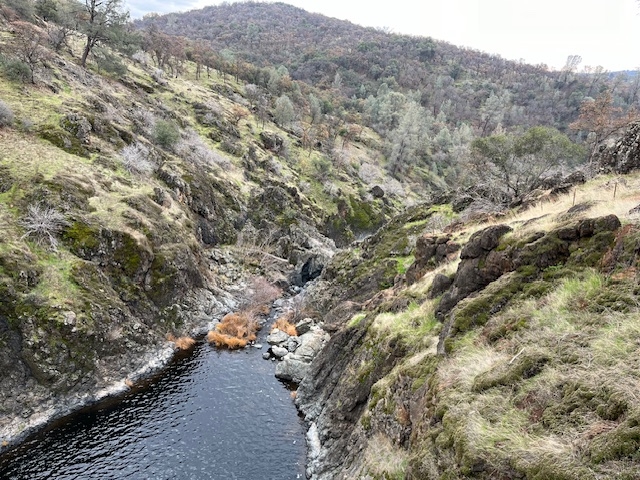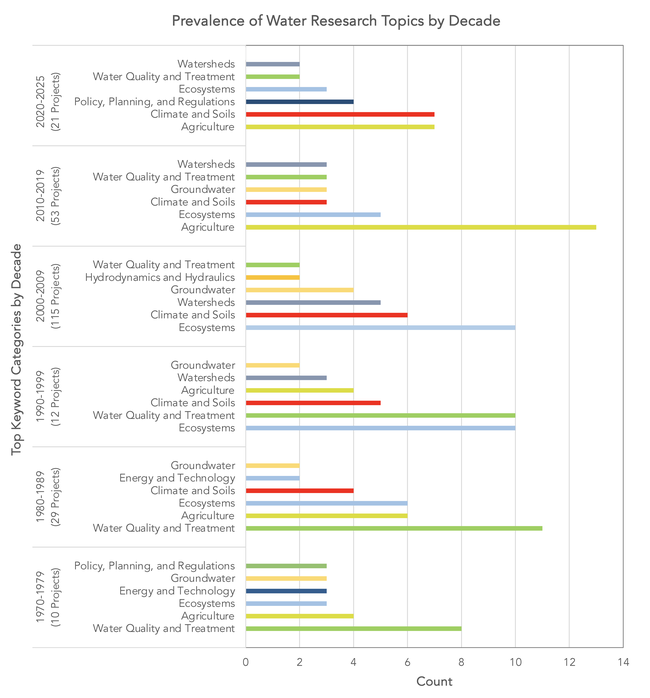
For decades, California has supported research to improve water resources management. Within our archives at the California Institute for Water Resources (CIWR), we have records of nearly 250 funded research projects going back fifty years. This led us to ask, how have water research topics in California changed over time?
First, let's step back in history. In 1957, with State Water Project construction looming, the California State Legislature funded the first University of California Water Resources Center at UCLA to provide training and research for water planning. Soon after, in 1964, the federal Water Resources Research Act authorized water research institutes in each state. In California, the existing UC Water Resources Center became part of the new network of federal institutes. Located first at UCLA, then UC Davis and UC Riverside, the Water Resources Center coordinated research, extension, and education activities, and also maintained California's Water Resources Center Archives. In 2011, the WRC reopened as the California Institute for Water Resources (CIWR) within the UC Division of Agriculture and Natural Resources (UC ANR).
For decades, CIWR and its predecessors have offered grants for water research at California's universities. The focus and scope of funded projects have evolved. From 1970 to 1999, the California Water Resources Center typically funded a few projects each year by University of California (UC) researchers. From 1999-2008, the program grew with state support and funded 7-20 research projects across five categories including hydrology, ecosystems, water quality, management, and law & policy. Since 2011, the California Institute for Water Resources has funded research projects at UC (campuses and extension) and California State University campuses. CIWR has administered nearly $2 million in federal funds, including $1 million to early career researchers, which are all matched by state funding. While these grants are only a small part of water research in the state, the grants for early career academics are an indicator of emerging water research in California.
From the database of funded projects, we analyzed project titles going back to 1970 using the keyword extraction model Keybert to identify keywords of projects in each decade from 1970 through 2025. We filtered the keywords for duplicate terms (i.e. hydrologic and hydrological) and removed geographic names (i.e. California). We analyzed the top keywords (up to 8 keywords) in each decade, then also grouped a larger set of keywords (40 keywords) using content analysis to evaluate broader research themes.

Groundwater is an area of recent high interest due to the Sustainable Groundwater Management Act (SGMA), but groundwater research has been prominent for decades. “Groundwater” was a top keyword from research topics in 5 of 6 decades. California has recognized groundwater management challenges for a long time. From 1970-2000, “sediment” and “aquatic” were prominent with increased research interests in water quality and habitat. After 1990, additional environmental keywords appeared, including “rivers”, “salmon”, and “ecosystem”, reflecting growing interest in broader environmental restoration goals in California water management. The keyword analysis also identified how research is influenced by management realities, with “drought” being a noted research topic in the 1980's, 2000's, and 2010's corresponding with several major drought periods in California. Agricultural water research grew after 2010 with CIWR's relocation as a statewide organization in the University of California and UC ANR.
Grouping keywords into themes of research revealed additional insights. Across decades, top themes have remained relatively consistent. From 1970-2000, water quality and treatment were key themes. During this time, wastewater treatment research expanded significantly, while the state established research in salinity management programs. Starting in the 1990's, research focusing on ecosystems exploded, reflecting broader policy and management challenges that arose with aquatic species habitat and the San Francisco-San Joaquin Delta. Agricultural water management research increased after 2010, explained in part by the incorporation of UC Cooperative Extension research in CIWR projects, but this also reflects the growing interest in adapting California's agricultural practices to changing climate conditions and water availability. Climate and soils research is a consistent topic and has become more prominent since 2020. Recent projects in this area especially incorporate needs to understand climate change effects on water resources, as well as research to understand links between water management, availability, and soil science.

This approach helps consider how future research in California water can align with policy and management goals. For instance, recent project titles do not directly reflect current policy goals for resilience and adaptation, even though such goals may underlie outcomes of current studies. Recent interest in equity as a policy goal is also not reflected. Contemporary tools in both research methods and policy implementation are inadequate to address the ambitious goals sought by policies such as the Human Right to Water (Assembly Bill 685). More research, outreach, and extension are needed.
California is a laboratory for water management innovations. State and federal support for research are important drivers of innovation. Research being developed by California's current early career academics will forge the water management solutions implemented in future decades.
Erik Porse is the Director of the California Institute for Water Resources and an Associate Cooperative Extension Specialist in the University of California Division of Agriculture and Natural Resources.
Author - Director of the California Institute for Water Resources and Associate Cooperative Extension Specialist